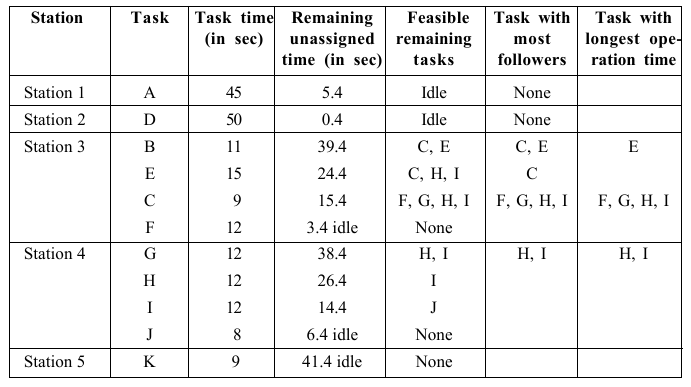| Task | Task time | Description | Tasks that |
| (in seconds) | must precede | ||
| A | 45 | Position rear axle support and hand fasten | – |
| B | 11 | Four screws to nuts | A |
| C | 9 | Insert rear axle | B |
| D | 50 | Tighten rear axle support screws to nuts | – |
| E | 15 | Position front axle assembly and hand | D |
| F | 12 | Fasten with four screws to nuts | C |
| G | 12 | Tighten front axle assembly screws | C |
| H | 12 | Position rear wheel 1 and fasten hubcap | E |
| I | 12 | Position rear wheel 2 and fasten hubcap | E |
| J | 8 | Position front wheel 1 and fasten hubcap | F, G, H, I |
| K | 9 | Position front wheel 2 and fasten hubcap | J |
Solution:
- Draw a precedence diagram as follows:

2. Determine workstation cycle time. Here we have to convert production time to seconds because our task times are in seconds

3. Determine the theoretical minimum number of workstations required (the actual number may be greater)

4. Select assignment rules.
(a) Prioritize tasks in order of the largest number of following tasks:
| Task | Number of following tasks |
| A | 6 |
| B or D | 5 |
| C or E | 4 |
| F, G, H, or I | 2 |
| J | 1 |
| K | 0 |
Our secondary rule, to be invoked where ties exist from our primary rule, is (b) Prioritize tasks in order of longest task time. Note that D should be assigned before B, and E assigned before C due to this tie-breaking rule.
5. Make task assignments to form workstation 1, workstation 2, and so forth until all tasks are assigned. It is important to meet precedence and cycle time requirements as the assignments are made.

6. Calculate the efficiency.

7. Evaluate the solution. An efficiency of 77 per cent indicates an imbalance or idle time of 23 per cent (1.0 – .77) across the entire line.
In addition to balancing a line for a given cycle time, managers must also consider four other options: pacing, behavioural factors, number of models produced, and cycle times. Pacing is the movement of product from one station to the next after the cycle time has elapsed. Paced lines have no buffer inventory. Unpaced lines require inventory storage areas to be placed between stations.
Total Views: 17
